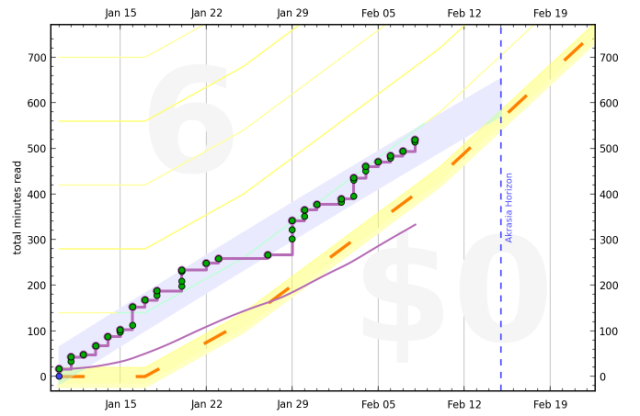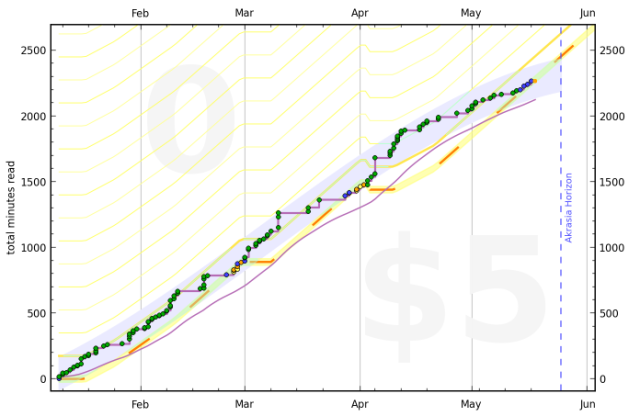So back in January, I started using a little service called Beeminder to track my goals and encourage me to do more things I’ve been putting off. I also experimented with several other Quantified Self tools, and learned a lot about how simply tracking what we do day to day can open our eyes to things we need to improve at and things we perhaps do too much of (for me, its instant messaging with my friends). It’s been five months since I started this journey of learning about myself, and I thought I’d give an update about how its been going.
My findings: I couldn’t be happier with the results.
I know its easy to get started on a new diet or workout program and feel all motivated and enthusiastic at first. That’s how New Year’s resolutions start, after all. We get all excited about changing our lives and then a few days or weeks later, its back to the same old same old. When I started tracking myself and using Beeminder for my goals, I was afraid a similar thing would happen. It’s just a fad, I thought. My newest obsession. It will subside in a few weeks. I’m happy to say that five months later, I am still going strong and I have made a lot of progress.
Wait, what is all this Beeminder/Quantified Self stuff? What are you talking about?
Glad you asked. I did a post on all this stuff a few months ago called Quantifying the Self and discussed the nuts and bolts of all this, but here’s a quick review:
Beeminder is a web service that allows you to track your goals by plotting progress points on a graph each day. You try to stay on “the yellow brick road” (that is, the goal you set for yourself — say, doing 20 pushups a day) and if you fall off the road, in order to recommit and get back on the road you pledge money (you’re basically “betting” that you will be able to keep up with your goal). If you fall off the road again, you pay up. Here’s a picture:
As you can see, the data points are staying above the yellow line, meaning I am on track for my goal. This screenshot was taken back in February, after I had been tracking my reading habits for only a month. Let’s take a look at my graph now:
There are a lot more data points, and I’ve racked up over 2000 minutes read (that’s 9 books) since January! There are a few flat parts (in March I did a lot of traveling and didn’t find a lot of time to read), and because of this I actually derailed once. But I pledged my $5 and so far I’ve been doing well once again. I really enjoy seeing the graph and the data points grow, and the Android App has been absolutely essential to my success. It doesn’t get much easier than entering in a few numbers into the app every day.
Of course, this is just my most successful graph. I have others that I have utterly failed at, like flossing my teeth:
This one…has a lot more flatlining. A product of good old akrasia. As you can see, I’ve derailed on this one and have been for quite some time…I think I’m about ready to pony up the cash and try again though (for real this time!) Some people have told me that paying the service money when you fail your goals seems cruel or manipulative on their part, but I don’t see it that way at all. This is something I want to do, and if I don’t follow through with it, then there has to be some sort of pain associated with that to deter me from failing again. And besides, this company has done so much for me and I use the service so much I am happy to give them a few bucks here and there. The staff is great and responsive and the website is always getting updates. They deserve it.
In addition, I’ve found from my pedometer app on my phone that I’ve walked over 600,000 steps this year! That’s over 300 miles. The day to day walking may not seem like much, but adding it all up like that certainly has a big impact on me and motivates me to keep going and do more.
My most recent project involves taming the beast that is my email inbox. I’ll admit it: I’m an email hoarder. While other people keep their inboxes neat, tidy, and organized, I have a giant deluge of thousands of emails just sitting there, taking up space and making it impossible to find anything. Usually, if I don’t find an email interesting (such as an advertisement or a newsletter) I won’t even click on it. Thus, there are hundreds of unread emails as well. This is a product of my laziness over time, and it just keeps getting worse. I’ve decided its finally time to do something about it. I set up a Beeminder goal to track my inbox size, and I’m going to either file away or delete 500 emails per week until my inbox reaches the fabled Inbox Zero. Once I reach that milestone, the challenge will be to keep it there, and keep my email inbox manageable and not overflowing like it was before. This leads to less stress, easier location of important emails, and if something is in the inbox, it means I need to deal with it right away. I feel like this will give great gains in productivity and overall happiness.
And just in the interest of transparency, my goals are all publicly viewable on my beeminder page, and that makes me not accountable to just one person, but the internet at large when you display your successes and failures in this way. There’s something strangely motivational about that.
What have I learned?
As for some of the other services, they didn’t stick quite as well. But the trial period of testing out these new things definitely taught me a lot about how my mind works and how we can battle this beast of distraction and bad judgement that rears its ugly head daily. Humans aren’t necessarily rational creatures by nature, but we can learn what mistakes we make and how our minds try to trick us. Then we can trick it right back. I just bought the book Thinking, Fast and Slow by Daniel Kahneman, and it discusses at length these “cognitive biases” and ways to get around them. The result? A happier, healthier, more productive life.
Final Thoughts
If you’re curious about what self-tracking can do for you, I urge you to try tracking a simple thing in your life, something you already do, for just a week. It becomes like a game to try to “beat your best score” and its really fulfilling to see your progress over time. I really recommend trying this to anyone that is interested in achieving their goals and improving their life. It’s surely changed mine.



I’m glad beeminder is working so well for you. I use a site called habitrpg.com and it has helped me get a lot done.
Hi Tyler! I have looked into habitrpg a little, but haven’t done much with it. I think it would be useful for daily “to-do” tasks though. I might write a post on it in the future after I try it out 🙂
[…] There were testimonials by Dr Kyra Gaunt, who says she “thrives by” Beeminder, and this math and computer science blogger who “couldn’t be happier with the results”. Cardsharp.ly describes Beeminder as “the most powerful productivity tool I know”. Jack […]
Loved your article! Thank you for sharing! I will start this beeminder too… Once I have deleted enough apps and videos from my phone…It’s full…. I need an app to delete apps from phone I don’t use that often… lol
[…] final way to do this is to put your money where your mouth is, as sometimes the harshest methods get the best results. Apps that allow you to bet money on your progress, or you could give money to a trusted friend and […]